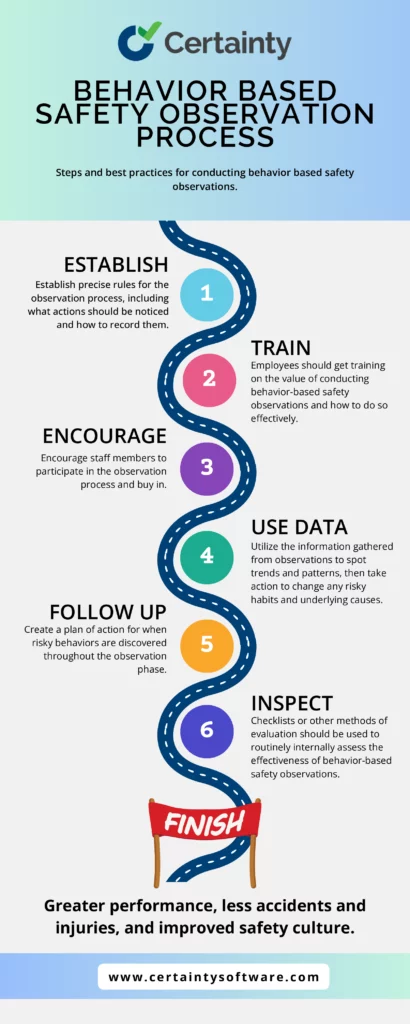Table of contents

A behavior based safety observation (BBSO) is a technique used to identify and correct unsafe behaviors in the workplace. It involves watching and analyzing the actions of employees while they work, with the goal of identifying any behaviors that may lead to accidents or injuries. This type of BBS observation is different from traditional safety programs, which focus on identifying and correcting hazards or deficiencies in the physical environment. Instead, behavior based safety observations focus on the actions of the workers themselves.
Examples of Behavior Based Safety Observations
Behavior based safety observations often reveal instances where employees are taking shortcuts in order to complete tasks more quickly or efficiently. These shortcuts may seem minor or insignificant at the time, but neglecting safe behaviors can have serious consequences if they result in accidents or injuries. For example, an employee may bypass safety protocols because they believe they can complete the task faster without following them. In this case, the employee is taking a risk in order to save time, and this risk-taking behavior can lead to accidents and injuries.
Here are some other instances of a Behavior Based Safety Observation:
- Witnessing an employee using a forklift and noticing that they are not wearing a seatbelt.
- Observing an employee working with hazardous chemicals and seeing that they are not wearing proper protective equipment (PPE).
- Noticing a co-worker using a ladder and noticing that they are not following proper ladder safety protocols, such as not maintaining three points of contact while climbing.
How Behavior Based Safety Observations are Measured
Behavior based safety observations are typically measured during a safety audit through the use of checklists or forms that outline specific behaviors that should be observed. These forms are often designed to identify both negative and positive behaviors and may include questions about the employee’s use of personal protective equipment, their adherence to safety protocols, and their overall attentiveness to safety issues.
Once the observations have been completed, the observation data collected is analyzed to identify trends and patterns in the data. This analysis can help businesses identify specific employee behaviors that may be contributing to a higher risk of accidents, injuries, and near misses, and allow them to deploy corrective actions.

30+ Audit and inspection checklists free for download.
Process vs. Behavior Based Safety Observations
Two distinct strategies for enhancing workplace safety are process-based safety observations and behavior-based safety observations. While preventing accidents and injuries is the goal of both approaches, their objectives and procedures are different. Some of the key variations between them are as follows:
Focus of Observation
Process based safety observations focus on identifying and correcting hazards or deficiencies in the physical environment, such as defective equipment or inadequate safety protocols. These observations are typically conducted by safety professionals or safety management and may involve inspections, audits, or other methods of evaluating the overall safety of the work environment.
Behavior based safety observations focus on the actions of individual workers and are often conducted by peers or supervisors. These observations are designed to identify and correct specific at-risk behaviors that may be contributing to a higher likelihood of accidents or injuries, rather than identifying and correcting hazards in the environment.
Source of Standards and Feedback
Process-based safety observations are frequently based on normative rules or laws that outline the essential conditions for safety. These standards are frequently established by outside organizations, such as OSHA or trade associations, and are upheld by inspections and sanctions.
Typically, behavior-based safety observations are focused on coaching or descriptive comments intended to help people perform better and behave better. The motivation behind this feedback, which is frequently given by internal sources like peers or superiors, is rewards or recognition.
Nature of Observation
Process-based safety observations are more reactive or corrective in character; they are prompted by events or complaints and concentrate on resolving issues that have already occurred or may arise in the future.
Behavior-based safety observations are typically more proactive or preventative in character, which refers to the fact that they are carried out frequently and constantly with the goal of avoiding problems before they start.
How to Implement Behavior Based Observations
Behavior-based safety observations are a continuous process that necessitates planning, implementation, evaluation, and improvement. Here are some best practices for performing effective behavior-based safety observations in your workplace to get you started:
1. Establish clear guidelines on the observation process what behaviors should be observed and how they should be recorded.
You can use a standardized form or checklist to identify the precise behaviors you wish to monitor and measure, such as the use of personal protective equipment, adherence to safety regulations, and overall safety awareness. This can help ensure that your observations and data collection are consistent and accurate.
2. Train personnel on the significance of behavior-based safety observations and how to conduct them correctly.
It’s crucial to inform your staff of the goals and advantages of behavior-based safety observations, as well as the requirements and obligations related to the procedure. Additionally, you must give them the abilities and information they need to conduct the observations successfully, including the ability to observe, document, and share their results. You can either conduct separate sessions for this purpose or incorporate behavior-based safety observation training into your regular workplace safety training program.
3. Encourage staff participation and buy-in in the observation process.
The participation and engagement of your employees are one of the most important elements for the success of behavior-based safety observations. In order to encourage employees to participate in the observation process and give feedback to their peers, you need to create a safe and friendly work environment. Employees who exhibit better or more positive behavior or who participate in the observation process can also be rewarded or recognized.
Fun Fact: In a 14-year study, researchers concluded that even having just 30% of employees engaging in behavior based safety observation showed increased performance in site-wide safety (2017).
4. Use the data gathered through observations to identify trends and patterns, and then take action to address any harmful behaviors and root causes.
The information from your behavior-based safety observations can give you important insights about your safety performance’s strengths and flaws as well as its potential for improvement. Regularly and methodically examine the data to search for any patterns or trends that point to potential dangers or concerns. The data should also be used to pinpoint and rectify any underlying issues or elements that may be promoting risky conduct, such as a lack of training, inappropriate tools, or poor supervision.
5. When risky behaviors are noticed during the observation phase, establish follow-up measures.
When risky behaviors are noticed, having an action plan that can be immediately put into place is essential for avoiding accidents and injuries. Any harmful behaviors that are noticed should be communicated and corrected according to a clear and consistent process that may include giving feedback, coaching, training, or punitive measures. Additionally, you should keep an eye on the results of your corrective activities, assess their effectiveness, and change as necessary.
6. On a regular basis, use checklists or other types of evaluation to internally inspect the execution of behavior-based safety observations.
By doing so, it is possible to make sure that the observation process is being carried out consistently and accurately and to spot any gaps or problems that might detract from its dependability or quality. Additionally, you ought to ask your staff for input on how they felt about the observation process so that you can make any necessary adjustments.
How to Get Your Free Behavior Based Safety Observation Checklist
Regular behavior-based safety observations are necessary if you want to enhance your safety culture and performance. A proactive technique to spot and address risky behaviors and conditions before they cause accidents or injuries is through behavior-based safety observations.
But how do you carry out efficient safety observations based on behavior? How do you make sure your observations are reliable, accurate, and useful? How do you keep track of, evaluate, and carry out improvement plans based on observation data?
Our free Behavior Based Safety Observation Checklist can be useful in this situation. You can conduct, record, and submit your behavior-based safety observations using this checklist.
Simply click here, complete the brief form, and you’ll be able to get your free Behavior Based Safety Observation Checklist right away. Don’t pass up this opportunity to improve performance and safety culture through behavior-based safety observations.
You may also be interested in:





